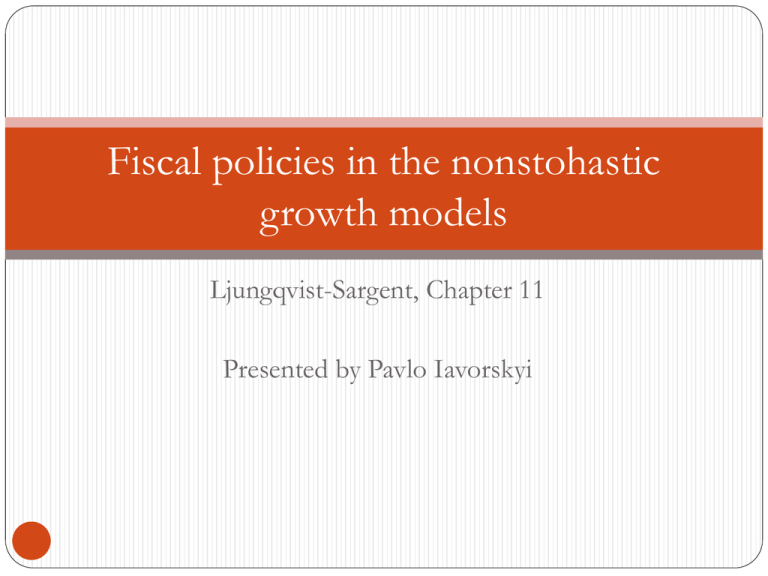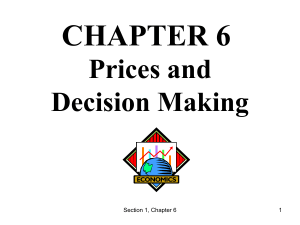Fiscal policies in the nonstohastic growth models
advertisement

Fiscal policies in the nonstohastic growth models Ljungqvist-Sargent, Chapter 11 Presented by Pavlo Iavorskyi Government. 2 𝑔𝑡 , 𝜏𝑐𝑡 , 𝜏𝑖𝑡 , 𝜏𝑘𝑡 , 𝜏𝑛𝑡 , 𝜏ℎ𝑡 , 𝑡 ≥ 0 𝑔𝑡 - a government spending; 𝜏𝑐𝑡 - a consumption tax rate; 𝜏𝑖𝑡 - an investment tax rate; 𝜏𝑘𝑡 - an “ earning from capital” tax rate; 𝜏𝑛𝑡 - an “ earning from labor” tax rate; 𝜏ℎ𝑡 - a lump sum tax; Preferences, technology, information. ∞ 𝛽𝑡 𝑈 𝑐𝑡 , 1 − 𝑛𝑡 (11.2.1) 𝑡=0 𝑈() is strictly increasing, strictly concave and twice continuously differentiable; Technology: 𝑔𝑡 + 𝑐𝑡 + 𝑥𝑡 ≤ 𝐹(𝑘𝑡 , 𝑛𝑡 ), 𝑘𝑡+1 = 𝑥𝑡 + (1 − 𝛿)𝑘𝑡 𝑔𝑡 + 𝑐𝑡 + 𝑘𝑡+1 ≤ 𝐹(𝑘𝑡 , 𝑛𝑡 ) + 1 − 𝛿 𝑘𝑡 (11.2.3) 𝐹(𝑘𝑡 , 𝑛𝑡 ) is homogeneous function with positive and decreasing marginal products. 3 Household, Government and Firm. ∞ 𝑞𝑡 1 + 𝑡𝑐𝑡 𝑐𝑡 + 𝑞𝑡 (1 − 𝑡𝑖𝑡 ) 𝑘𝑡+1 + (1 − 𝛿)𝑘𝑡 𝑡=0 ∞ ≤ 𝑟𝑡 1 − 𝑡𝑘𝑡 𝑘𝑡 + 𝑤𝑡 1 − 𝑡𝑛𝑡 𝑛𝑡 − 𝑞𝑡 𝜏ℎ𝑡 (11.2.4) 𝑡=0 ∞ ∞ 𝑞𝑡 𝑔𝑡 ≤ 𝑡=0 𝜏𝑐𝑡 𝑞𝑡 𝑐𝑡 − 𝜏𝑖𝑡 𝑞𝑡 𝑘𝑡+1 + 1 − 𝛿 𝑘𝑡 + 𝑟𝑡 𝜏𝑘𝑡 𝑞𝑡 + 𝑤𝑡 𝜏𝑛𝑡 𝑞𝑡 + 𝑞𝑡 𝜏ℎ𝑡 𝑡=0 (11.2.5a) ∞ 𝑞𝑡 𝐹 𝑘𝑡 , 𝑛𝑡 − 𝑟𝑡 𝑘𝑡 − 𝑤𝑡 𝑛𝑡 𝑡=0 4 𝑞𝑡 , 𝑟𝑡, 𝑤𝑡 is a price system. (11.2.5𝑏) Competitive equilibrium with distorting taxes Definition. A competitive equilibrium with distorting taxes is a budget feasible government policy 𝑔𝑡 , 𝜏𝑐𝑡 , 𝜏𝑖𝑡 , 𝜏𝑘𝑡 , 𝜏𝑛𝑡 , 𝜏ℎ𝑡 that satisfy (11.2.5a); a feasible allocation 𝑐𝑡 , 𝑥𝑡 , 𝑛𝑡 , 𝑘𝑡 that given the price system 𝑞𝑡 , 𝑟𝑡, 𝑤𝑡 and the government policy solves the household’s(11.2.1, 11.2.4) and the firm’s (11.2.3, 11.2.5b) problems. 5 No arbitrage condition. ∞ ∞ 𝑞𝑡 1 + 𝑡𝑐𝑡 𝑐𝑡 ≤ 𝑡=0 ∞ + ∞ 𝑤𝑡 1 − 𝑡𝑛𝑡 𝑛𝑡 − 𝑡=0 𝑞𝑡 𝜏ℎ𝑡 (11.2.6) 𝑡=0 𝑟𝑡 1 − 𝑡𝑘𝑡 + 𝑞𝑡 1 − 𝑡𝑖𝑡 1 − 𝛿 − 𝑞𝑡−1 1 − 𝑡𝑖𝑡−1 𝑘𝑡 𝑡=1 + 𝑟0 1 − 𝑡𝑘0 + 𝑞0 1 − 𝑡𝑖0 1 − 𝛿 𝑘0 + lim 𝑞𝑇 1 − 𝑡𝑖𝑇 𝑘 𝑇+1 𝑇→∞ 𝑞𝑡 1 − 𝑡𝑖𝑡 = 𝑞𝑡+1 1 − 𝑡𝑖𝑡+1 1 − 𝛿 + 𝑟𝑡+1 1 − 𝑡𝑘𝑡+1 6 (11.2.8) Household’s and Firm’s Problem. Household’s Euler equations: 𝛽𝑡 𝑈1𝑡 = 𝜇𝑞𝑡 1 + 𝜏𝑐𝑡 𝛽𝑡 𝑈2𝑡 ≤ 𝜇𝑤𝑡 1 − 𝜏𝑛𝑡 (11.2.10a) (11.2.10b) Firm’s zero-profit conditions: 𝑟𝑡 = 𝑞𝑡 𝐹𝑘𝑡 𝑤𝑡 = 𝑞𝑡 𝐹𝑛𝑡 7 (11.2.11) Computing equilibrium. 1. Assumptions: 𝑈 𝑐, 1 − 𝑛 = 𝑢 𝑐 , inelastic labor supply, full employment. 𝑘𝑡+1 = 𝑓 𝑘𝑡 + 1 − 𝛿 𝑘𝑡 − 𝑔𝑡 − 𝑐𝑡 𝑢′ 𝑐𝑡 = 𝛽𝑢′ 𝑐𝑡+1 1+𝜏𝑐𝑡 1+𝜏𝑐𝑡+1 1−𝜏𝑖𝑡+1 1−𝜏𝑖𝑡 1−𝛿 + 1−𝜏𝑘𝑡+1 1−𝜏𝑖𝑡 (11.3.1) 𝑓 ′ (𝑘𝑡+1 ) (11.3.3) At steady state capital level and tax rates are constant: 𝑓 ′ (𝑘) = (𝜌 + 𝛿) 8 1−𝜏𝑖 1−𝜏𝑘 (11.3.7) Computing equilibrium. 2. 𝑐𝑡 = 𝑓 𝑘𝑡 + 1 − 𝛿 𝑘𝑡 − 𝑔𝑡 − 𝑘𝑡+1 𝑞𝑡 = 𝛽 𝑡 𝑈1𝑡 1+𝜏𝑐𝑡 𝑟𝑡 = 𝑓 ′ (𝑘𝑡 ) 𝑞𝑡 𝑤𝑡 = 𝑓 𝑘𝑡 𝑞𝑡 𝑅𝑡+1 = 𝑠𝑡 𝑞𝑡 1+𝜏𝑐𝑡 1+𝜏𝑐𝑡+1 (11.3.8a) (11.3.8b) (11.3.8c) − 𝑘𝑡 𝑓 ′ (𝑘𝑡 ) 1−𝜏𝑖𝑡+1 1−𝜏𝑖𝑡 1−𝛿 + = (1 − 𝛿) − (1 − 𝜏𝑘 )𝑓 ′ (𝑘𝑡 ) (11.3.8d) 1−𝜏𝑘𝑡+1 1−𝜏𝑖𝑡 𝑓 ′ (𝑘𝑡+1 ) (11.3.8e) (11.3.8f) 𝑠𝑡 is the per unit value of the capital stock at time t measured in units of time t consumption. 9 Computing equilibrium. 3. 10 𝑅 = (1 + ρ) (11.3.10) 𝑠 𝑞 (11.3.11) = 1 + 𝜌 + (𝜌 + 𝛿)𝜏𝑖 Remarks. The equilibrium allocation in the “only lump sum tax” case is identical to the one that solves planning problem in which government spending is taken as an exogenous stream that is deducted from output; When labor is inelastic, constant 𝜏𝑐 and 𝜏𝑛 are not distorting; Variations in 𝜏𝑐 over time are distorting; Capital taxation is distorting. 11 Experiments. 1. Assumptions: 𝑢 𝑐 = 𝑐 1−𝛾 , 1−𝛾 𝑓 𝑘 = 𝑘 𝛼 , δ = 0.2, 𝛾 = 2, 𝛽 = 0.95 Responses to foreseen permanent increase in g at t = 10. 12 Experiments. 2. Responses to foreseen permanent increase in 𝜏𝑐 at t = 10. 13 Experiments. 3. Responses to foreseen permanent increase in 𝜏𝑖 at t = 10. 14 Experiments. 4. Responses to foreseen permanent increase in 𝜏𝑘 at t = 10. 15 Experiments. 5. Responses to foreseen one-time increase in g at t = 10. 16 Experiments. 6. Responses to foreseen one-time increase in 𝜏𝑖 at t = 10. 17 Technology Growth. 1. 𝑌𝑡 = 𝐹(𝑘𝑡 , 𝐴𝑡 𝑛𝑡 ) 𝐴𝑡+1 = 𝜇𝑡+1 𝐴𝑡 𝑘𝑡+1 = 𝜇𝑡+1 −1 (11.9.1) (11.9.2) 𝑓 𝑘𝑡 + 1 − 𝛿 𝑘𝑡 − 𝑔𝑡 − 𝑐𝑡 𝑢′ 𝑐𝑡 𝐴𝑡 = 𝛽𝑢′ 𝑐𝑡+1 𝐴𝑡+1 1+𝜏𝑐𝑡 1+𝜏𝑐𝑡+1 1−𝜏𝑖𝑡+1 1−𝜏𝑖𝑡 1−𝛿 + (11.9.4) 1−𝜏𝑘𝑡+1 1−𝜏𝑖𝑡 𝑓 ′ (𝑘𝑡+1 ) (11.9.5) 𝑓 ′ (𝑘) = 18 1 + 𝜌 𝜇 𝛾 − (1 − 𝛿) 1−𝜏𝑖 1−𝜏𝑘 (11.9.8) Technology Growth. 2. 19 𝑅 = (1 + ρ)𝜇 𝛾 (11.3.9) 𝑆 𝑞 (11.3.10) = 1 − 𝜏𝑖 (1 + 𝜌)𝜇 𝛾 + (1 − 𝛿)𝜏𝑖 Experiments. 7. Responses to foreseen permanent increase in productivity growth at t = 10. 20 Experiments. 8. Responses to unforeseen permanent increase in productivity growth at t = 1. 21 Questions? 22






